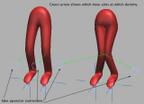|
|
 |
|
Advanced IK Setups Added on: Thu Aug 03 2000 |
| Page: 1 2 3 4 5 6 7 8 9 10 |
Why Type 1 Doesnt work in all situations.
Type 1 is a very good setup to start with. But if you're a serious animator, you'll find its flaw right away. Earlier in this tutorial, I mentioned an Up-vector constraint. Most Softimage and Maya animators are very familiar with this term. An up-vector constraint is something that max cant do. There are ways of getting around that down fall though. However they are not in any means as good, or as user friendly as having a nice constraint system.
So what does this mean for max animators. Well, Ok so what?
We dont have an up-vector constraint. You're project is due, you have to animate. Well you'll just have to figure out another way to control your chain's up-vector plane. That or use the incredible ik/fk system of biped to do your "freeform" animation.
What do animators use up-vector constraints for?
The most common use is the elbow/knee aim.

In this diagram we see how an up-vector constraint works. The skeleton in this system uses the Type 2 setup. Since Max doesnt have an up-vector constraint, we're faking it using a look at controller. We'll talk about this setup more in the Type 2 setup section. For now just know that this is a Type 2 setup, and is a skeletal setup in Max.
Back to the diagram, As you can see, we're using a dummy to controll which way the knee aims. We can have it look straight ahead, or we can have the knees look at each other, in that "knee knocking, terrorfied Woody from Toy Story pose".
This type of control is very important. I can't stress how much important this is. Without this type of control your skeleton will be missing one of the primary degrees of freedom of a human skeleton. Actually you'll have the degree of freedom, but without this kind of constraint, or faking the constraint.... you'll lose the ability to control it.
Although you could put an end effector at your knee joint, that would work just as well atcually but you'd have to keyframe it a lot more. The worst part about having an end effector at the knee is the result of the IK solution. More end effectors mean slower IK, and less accuracy because the IK solver is trying to fit your skeleton to multiple end effectors.
Note, Biped in Character Studio features a very nice and easy way to aim your knees and elbows. But Biped is its own system and sometimes doesnt fit everyones need. I do recommend that if you're animating a bipedal character, Biped should be you're first choice of doing so in max. It is an incredible system that has an ik/fk seamless functionality that goes far beyond even maya and softs IK in terms of control.
Where biped fails to compare is in the fact that it is a closed system. It is a Bipedal character and no more. But for Bipedal characters it is an excellent system for hand animation.
|
 |
|
|


